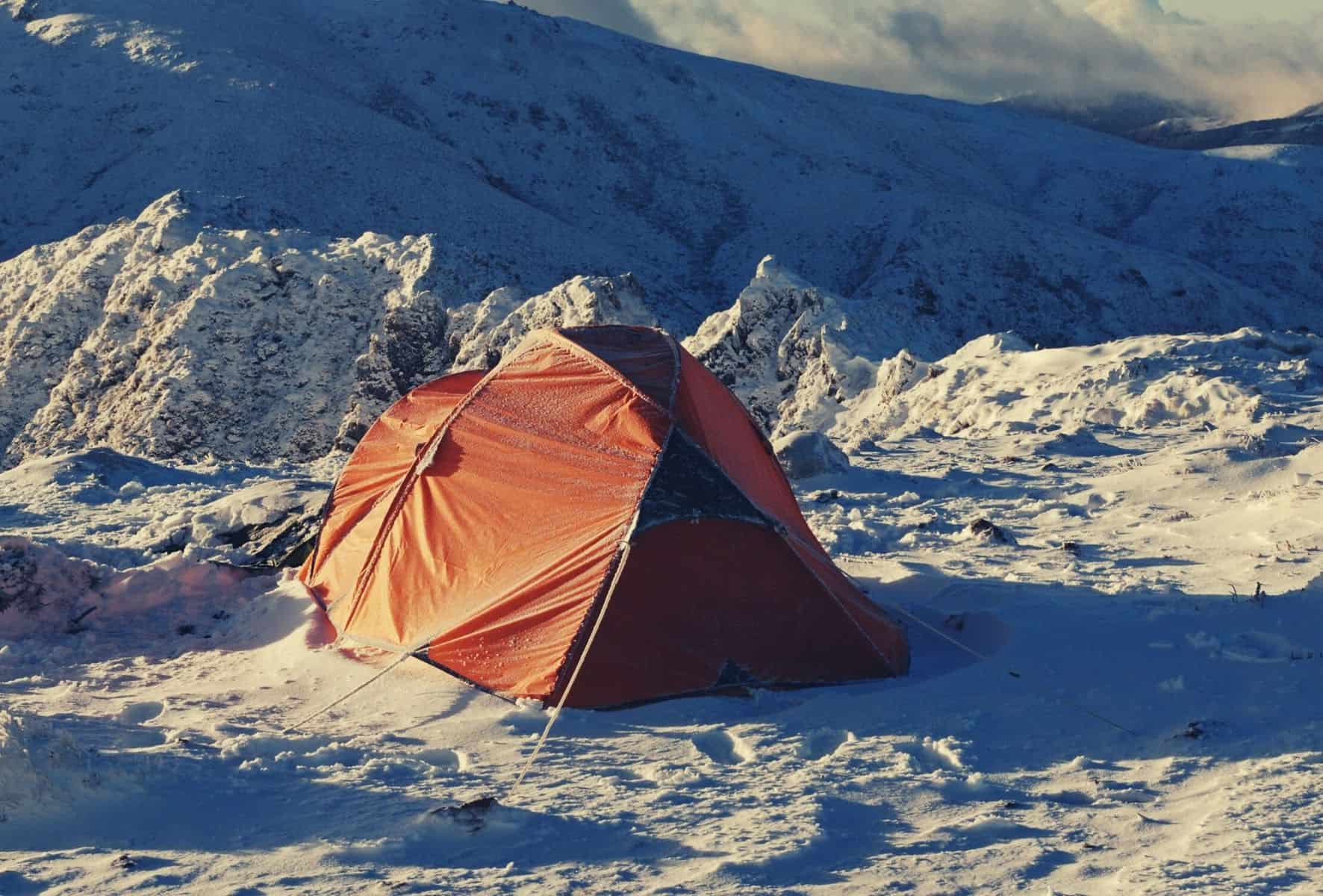The extra insulation, enhanced durability, and features like snow skirts or extra anchor points are vital to the practicality of using a tent in winter. However, these enhancements come at a cost, a four-season shelter is one of the more expensive pieces of camping equipment available. Nonetheless, the cost is justified considering these tents offer both comfort and crucial protection for all seasons.
Great 4-season models at an affordable price point can be hard to find, but they are available. We evaluated the top models on the lower end of the price spectrum and decided the ALPS Mountaineering Tasmanian 2 was our top choice. Close contenders included the GeerTop Toproad 2, Black Diamond Firstlight 2P, WoneNice 2 Person Double Layer Tent, and the MIER 3-Person Lightweight Camping Tent.
To aid your decision-making process, we also include some helpful buying advice. We discuss the distinction between 3-season and 4-season tents, selecting a tent based on its intended use, weatherproofing, structural design, whether it is single or double-walled, durability, packed size & weight, square footage, peak height, as well as ventilation.
Table of Contents
What Are The Best Budget Tents For 4-Seasons?
After extensive review, we selected the GeerTop Toproad 2 as our top choice for an affordable winter tent, with the other top contenders listed below.
- GeerTop Toproad 2
- ALPS Mountaineering Tasmanian 2
- Black Diamond Firstlight 2P
- WoneNice 2 Person Double Layer Tent
- MIER 3-Person Lightweight Camping Tent
GeerTop Toproad 2
Editors ChoiceThe Toproad 2’s remarkable versatility, and its value for money, are why it stands out as our top choice among the strong contenders in our list of best affordable 4-season tents.
Designed for all-season camping, it has standard protection for snowy conditions with sealed waterproof seams, a robust anti-tear checkered polyester rainfly with a 3000 mm coating, and adequate ventilation for comfortable rest. During summer, the inner canopy without the rainfly has a combination of nylon fabric and no-see-um fine nylon mesh to ensure a pleasant camping experience.
The canopy, however, resembles that of smaller 2-person tents. With a width of just 4 ft and 7 inches, this could potentially lead to a cramped and crowded sleeping space.
Lastly, the Toproad 2’s set-up is also beginner-friendly. The typical dome shape and single intersection on top doesn’t make for a challenging and long pitch. But its zippers do tend to get snagged on the fabric and, in some cases, get stuck and may even fail.
- Capacity: 2-person
- Weight: 5.7 lbs
- Floor dimensions: 6’11 x 4’7
- Wall(s): Double
- Category: Treeline, Basecamp
PROs
- Versatile
- Good balance between mesh and fabric
- Easy to set up
CONs
- Small for a 2-person tent
- Might have failing zippers
ALPS Mountaineering Tasmanian 2
Best Value TentThe Tasmanian is primarily a recreational snow tent. It’s not suited for expeditions or frequent use on rough trails, particularly in severe weather conditions. Nevertheless, it provides adequate protection for casual campers against snowfall and 40 mph winds.
This treeline tent is suitably durable with its own form of weatherproof shock cords, 75D polyester fly and poly taffeta floor, 7000 series aluminum poles, UV protection, and standard 1500 mm wall and 5000 mm floor coating. There’s also an additional pole that goes across the tent to stabilize it against strong gusts. That’s enough protection from the elements for a long winter camp out with friends and family.
Like many a 4-season tent, this tent is still only limited to snowy environments. The thick walls and ventilating windows aren’t enough to make this tent comfortable during hotter seasons, even if the fly is down.
Additionally, if you can get past the minor inconvenience of the additional poles occasionally snagging in the hooped vestibules, pitching the tent is smooth and easy. Casual hikers will still find it very convenient to set up with its continuous pole system, especially with the helpful hubs that extend on both ends of the tent.
The Tasmanian is also roomier than most shelters prescribed for two people. It’s safe to say that it’s built for tall individuals. So you’ll have more legroom and enough space for storage right by the door. However, that large size does contribute to its heavyweight and overall bulk. Because of that, it has a considerable packing size.
- Capacity: 2-person
- Weight: 8 lbs
- Floor dimensions: 5’2 x 7’8
- Wall(s): Double
- Category: Treeline
PROs
- Great for winter camping
- Weather-resistant
- Easy to Set Up
- Long and roomy
CONs
- Heavy and bulky
- Inner canopy isn’t suited for warmer seasons
Black Diamond Firstlight 2P
Best Tent for MountaineeringAlpinists on a tight budget should consider the two-person Black Diamond Firstlight. It’s best for fast high-alpine expeditions in dry conditions.
Officially, the Firstlight isn’t labeled as an ultralight tent because it sits comfortably in its own Goldilocks zone, not too light to trump ultralights but not too heavy to be a run-of-the-mill 4-season tent either. With its confident minimalist design, small footprint, and low packing volume, it’s a viable ultralight substitute for cost-conscious climbers.
Another contributory factor to the Firstlight’s weight is its NanoShield fabric. Because it’s an alpine tent, it has understandably forgone the bulky waterproofing coat and went with a water-resistant silicone coating.
In frigid temperatures, the insulation and coating would be enough to protect against dry snow and wind. But obviously, this bivy tent won’t sit well in wet and humid environments. It’s best to treat the seams with waterproof seals yourself.
To add, the Firstlight also experiences ventilation setbacks as with many a 4-season tent. The NanoShield fabric is not as breathable as it’s expected to be. Condensation forms now and then and engulfs the walls with dew in the morning. Again, the Firstlight only thrives in dry and cold conditions.
- Capacity: 2-person
- Weight: 3.3 lbs
- Floor dimensions: 6’10 x 4
- Wall(s): Single
- Category: Mountaineering
PROs
- Lightweight
- Easy to Set Up
- Small packing size
- Small footprint
- High-quality
- Insulated
CONs
- Less breathable fabric and poor ventilation
- Not waterproof
WoneNice 2 Person Double Layer Tent
Best Budget TentOverall, the WoneNice 2-P double-wall tent serves as a decent outdoor option for beginner hikers seeking budget-friendly gear with its entry-level design able to withstand both snow and rain.
The standard UV coating, 3500 mm polyester fly, and extended snow skirt effectively keep the elements out. Moreover, the 4000 mm waterproof base ensures a comfortable and dry floor for sleeping, even when placed on damp ground. It is also durable enough to resist tearing against sharp rocks.
However, the WoneNice tent isn’t for extended stays and major storms and snowfall. You might experience durability issues with the poles and the fabric itself when used long during severe weather.
Though it is a basecamp tent, it’s better for casual winter camping with family and friends. Don’t expect expedition-grade durability from the WoneNice 2-Person tent.
- Capacity: 2-3 persons
- Weight: 5.9 lbs
- Floor dimensions: 4’11 x 6’11
- Wall(s): Double
- Category: Treeline, Basecamp
PROs
- lowest price
- strong waterproof floor
CONs
- durability issues
- Not so easy to set up
- heavy and bulky
MIER 3-Person Lightweight Camping Tent
Most Beginner-Friendly TentFor novice trekkers, the lightweight and easy-to-assemble Mier 3-person tent presents a smart option.
It can accommodate 3 people while weighing less than 6 lbs. Distributing the weight of this tent among 3 people during a backpacking trip is far less taxing compared to each person carrying the typical 4-pound 3-season tent individually!
The Mier 3-person tent also comes with the common free-standing dome frame and easy clips for a fast set-up, a lightweight footprint, and a repair kit–– an excellent starter set for budding outdoor enthusiasts.
But like any more affordable tent in the 4-season category, the Mier camping tent has its own weather issues. It may have a 15D nylon fly, partially sealed seams, and an impressive 40D bathtub floor. But, it just can’t withstand too much snow and rain. The thinner 7001 aluminum poles could also break faster when faced with high winds and repeated use. It is made to be a treeline, after all.
- Capacity: 3-person
- Weight: 5.5 lbs
- Floor space: 30 sq. ft.
- Wall(s): Double
- Type: Treeline
PROs
- Lightweight
- Easy to set up
- Comes with a free footprint
CONs
- Not for severe weather
- Less durable poles
How to Select the Best Budget Tent For Camping In Winter?
There are a number of considerations and features to take into account when buying a 4-season tent, as outlined in the list below.
- 3-season vs. 4-season
- Purpose
- Weatherproofing
- Structural design
- Single-wall vs double-wall
- Durability
- Packed Size & weight
- Square footage
- Peak height
- Ventilation
3-season vs. 4-season
The distinction between a 3-season and 4-season tent is based on the maximum number of seasons the tent can withstand the elements. However, this doesn’t mean all 4-season tents are suitable for year-round use. In reality, the term ‘4-season’ can be misleading. A considerable number of 4-season models are only appropriate for winter use since they will trap heat becoming uncomfortably hot if used in warmer months.
Therefore, a 3-season tent is labeled as such because it’s built for three seasons: spring, summer, and fall. Depending on the model it should have features to deal with the variety of weather in these seasons. Its 4-season counterpart is designed to endure winter conditions which may render it unsuitable for summer camping in particular.
In its essence, the 4-season tent is designed to insulate during plummeting temperatures, withstand harsh storms, heavy snowfall (not blizzards), and wind speeds ranging from 30 to 60 mph. It’s constructed with higher denier materials, more guy-out points, and A-frame poles to prevent wind damage, sagging, and snow loading. So it’s better for camping in harsh conditions.
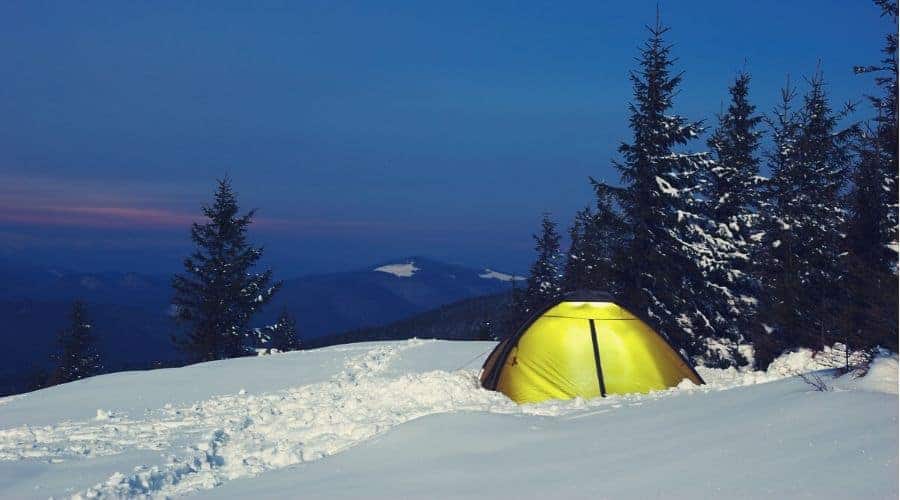
Purpose
The intended purpose of a casual hiker versus an aspiring alpinist means their shelter priorities will vary greatly when choosing a four-season tent. Options vary in shape, size, and, ultimately, in function. So choosing one depends on how, where, and when you’re going to use it.
There are three kinds of 4-season backpacking tents, all classified according to their intended use: treeline, mountaineering, and basecamp tents.
Treeline Tents
If you’re primarily engaging in regular and casual winter camping, your best option is treeline tents. Designed for light snowfall and moderate winds, they may appear similar to the 3-season variety, 4-season treeline tents typically feature larger floor areas and denser canopies with reduced mesh.
Mountaineering Tents
These heavy-duty tents are engineered for use mountaineering at high altitudes. Their main purpose is to support climbing in extremely harsh conditions, so they are designed to be lightweight and durable while being able to withstand gusts of more than 30 mph.
Mountaineering tents usually have no rainfly, and they have limited floor dimensions and a short height. It may feel cramped inside, but the small size helps the tent become more aerodynamic, giving less space for the high altitude winds to ram into. They also have highly wind-resistant poles and sturdy waterproof fabric.
Basecamp Tents
If you want something sturdier than a treeline model but more spacious than a mountaineering tent, opt for a basecamp tent.
They offer similar weather resistance to mountaineering backpacking tents but are heavier and more spacious. Due to the added weight, these tents are pitched at a basecamp rather than carried up to the summit. They also come with double walls for improved ventilation and added comfort during longer trips.
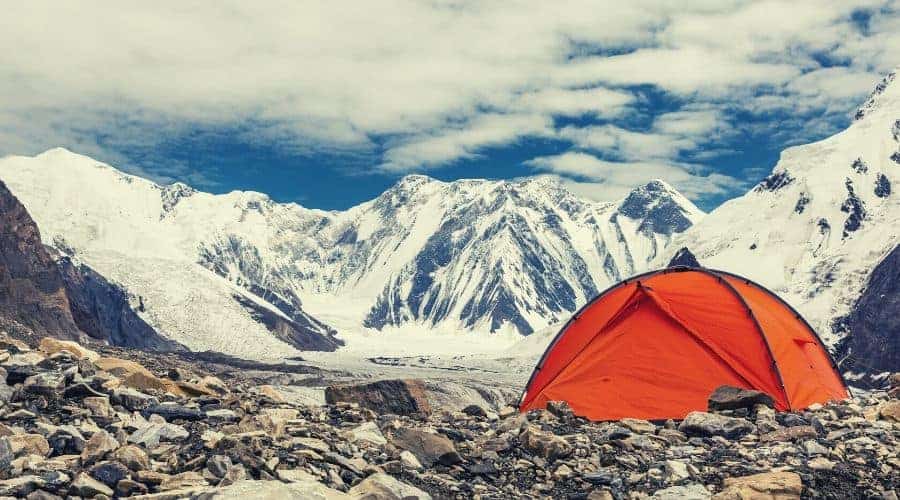
Weatherproofing
A 4-season tent’s weatherproofing performance is significantly affected by its coating and waterproofing.
Coating
Depending on the brand, 4-season tent walls are always coated with a protective layer, most commonly with Durable Water Repellent (DWR). This causes water to bead up on the rainfly’s exterior, preventing it from seeping through.
Great tents are also coated with UV protection since climbers are more exposed to the sun’s ultraviolet rays at higher altitudes. Without an anti-UV coat, the sun could wear the tent out faster and affect the campers inside.
Waterproofing
Waterproofing is a non-negotiable aspect of a 4-season tent, ensuring it keeps you warm and dry even in harsh weather conditions. It’s essential to have a water-sealed base and seams, along with a high water resistance grade. The walls should ideally have a Hydrostatic Head (HH) coating index above 1500 millimeters, while the floor should have an HH of 4000 to 8000 mm to prevent leaks.
In contrast, since not all 4-season models are genuinely fitted to match all types of weather, many of them may not be water-resistant at all–– and that’s fine as long as they’re used in the correct environment.
Perhaps the most suitable example of this is the Black Diamond Firstlight. This 4-season tent is a true snow tent that categorically performs best in deep wintery conditions with below-freezing temperatures.
The Firstlight won’t ever need the bulkiness of a full waterproofing coat on its fabric since there’s no melting snow in frigid temperatures that can seep through the walls. The DWR coating would be enough defense for the very minute water particles that try to get through.
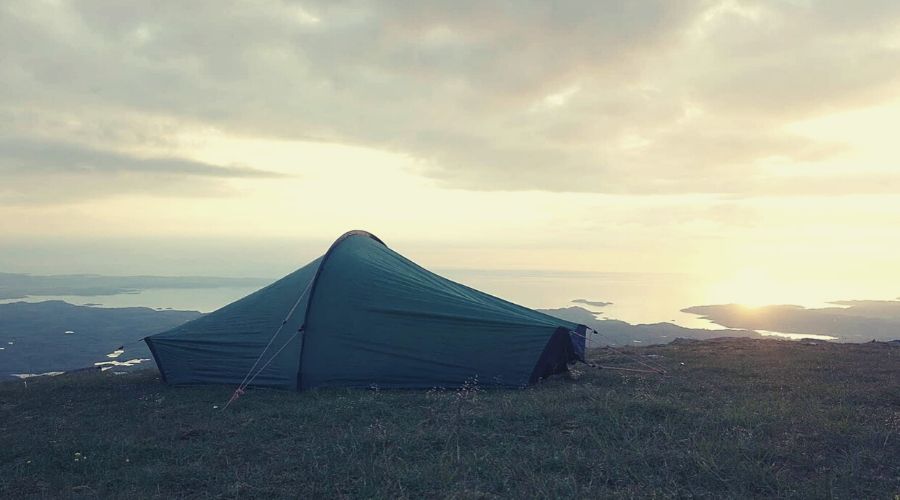
Structural design
For the optimal 4-season tent, choose a rounded structural design with a low profile. Dome, mountaineering, and basecamp models, as mentioned earlier, feature spherical aerodynamic designs that sit comfortably close to the ground.
The specific shape and sloping of the walls let the snow slide down to the sides, avoiding a massive and damaging pile on the roof. The roundedness also means less surface for the air to act against, preventing the structure from toppling over.
Single-wall vs double-wall
Tents can be categorized as having either a single or double-wall design which affects the level of protection and ventilation they provide. A double-wall tent comprises two layers, a rainfly, and an inner canopy. The rainfly is the outer layer, while the canopy is where campers sleep. A single-wall tent has no rainfly, and is therefore lighter, with the canopy built to be durable enough to compensate for the single layer.
In almost all aspects, 4-season double-wall tents can trump their single-wall counterpart. With two layers, they give ample protection against the elements. Next, the multifunctioning rainfly provides vestibules that can act as extra storage space for wet and dirty gear. And lastly, the mesh parts of the inner canopy and the spacious vestibules help ventilate the tent and promote free-flowing air. This is hugely helpful in humid environments.
In comparison, 4-season single-wall tents shine most when scaling towering mountains. Their compact size and light trail weight are meant for vertical ascents. They’re built for high altitude winter landscapes. Single-wall four-season tents are mostly mountaineering types.
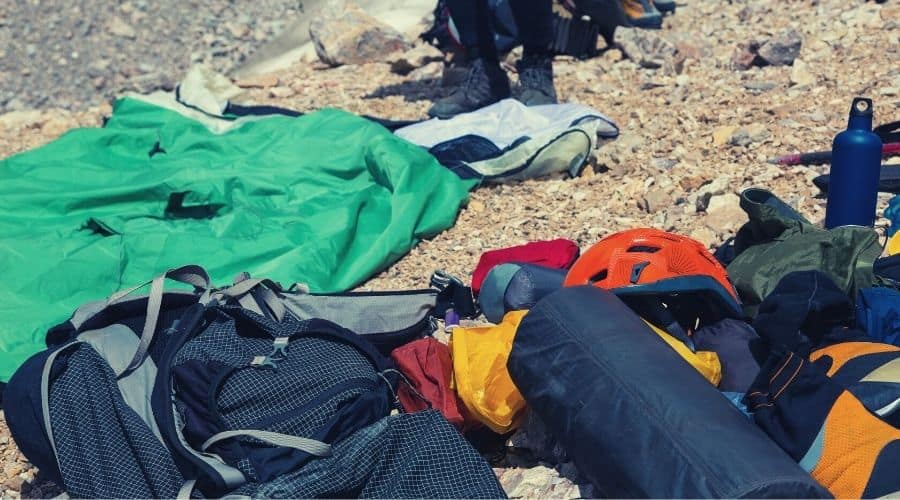
Durability
The durability of a tent is based on the type and denier rating of the fabric used and the composition and quality of the tent poles.
In terms of the tent fabric, the standard material is 70D or 70 denier Nylon Taffeta. For comparison, nylon used in other season-rated models is typically around 40 deniers. High denier ratings are essential for winter tents as snow can be abrasive and damaging. Durable, heavy-duty nylon can withstand not only snow but also the high wind force. Sturdy zippers also offer protection against tearing and the elements.
For pole quality, all-season tents will generally have stronger and heavier poles to help the tent hunker down against powerful gusts.
Carbon fiber and aluminum poles are popular because of their durability, high strength to weight ratio, and quality finish. However, carbon fiber poles have proven to be more superior in strength and weight. The only downside to them is their high price. It’s rare for the cheapest tents to have this type of pole.
Stay away from poles with plastic tips. They brittle easily and can get broken off after a few months of pitching on cold weather. DAC produces quality Wind Lab tested poles that are used by established brands such as MSR. Their stout poles provide torsional strength to avoid shredding.
Packed Size & weight
A tent is likely the most cumbersome piece of gear inside your backpack making packed size and weight a key consideration. And for 4-season models, the weight is a particularly significant issue (especially for double-walled tents).
Most of these tents have an average weight of 6.6 lbs. That accounts for the burly construction, high denier fabric, roomier floor dimensions, more spacious vestibules, and heavy-duty poles and pegs. For reference, that’s 2 to 4 lbs heavier than a typical two or 3-season tent.
Even without measuring it, you can recognize a tent’s weight just by looking at its packing size. This is its size when it’s compressed into a sack or storage duffle bag. A bigger packed size will broadly correspond to a heavier tent since thicker fabric, two layers, more rigid coating, and a larger floor all add up.
Aside from just being heavy, a bulky packing size can take up significant space inside a bag, leaving less room for other vital items and gear.
So when selecting the tent that’s best suited for you, find the balance between weight, price, and durability. Budget tents are typically big, double-wall, heavy, and durable, while lightweight tents are usually less heavy-duty and more expensive.
Square footage
The floor area or square footage varies from spacious to minimal, depending on the tent’s intended use. Treeline and basecamp types typically offer more interior space, so prioritize them if space is a key consideration for you.
For instance, the Black Diamond First Light has a floor area of 27.3 sq. ft, whereas the ALPS Mountaineering Tasmanian 2 offers 39.6 sq. ft. The former belongs to the mountaineering variety, while the latter is a treeline type. Since both are made for distinctive conditions, it makes sense that they’d be sized differently.
Peak Height
The peak height, measured on the spot where the ceiling is farthest from the base, is another critical consideration for a tent. Sufficient height allows campers to sit upright and move comfortably inside. However, shorter tents are preferable for mountaineering and expeditions as they’re nearer to the ground and have a slighter angled surface for winds to blow against.
Choose tents that have cross-bracing poles attached to the ceiling. These intersections provide more vertical space and enhance the tent’s lateral stability against strong gusts.
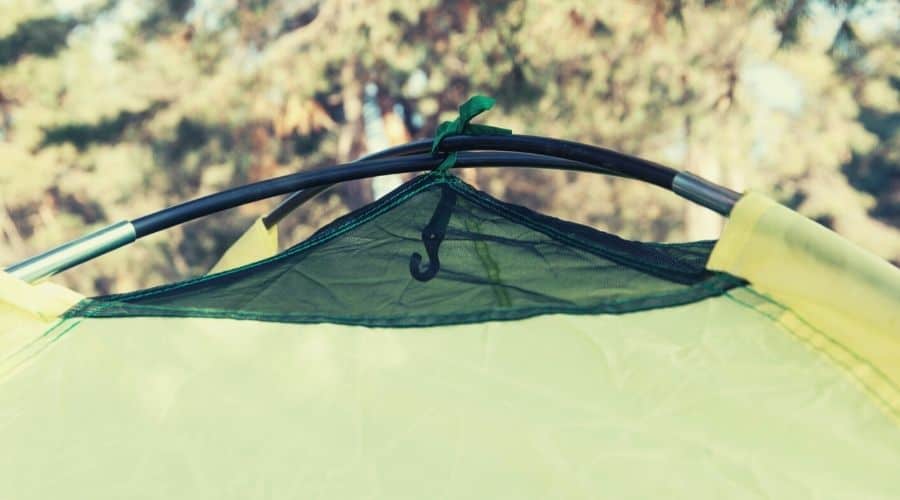
Ventilation
The last thing to consider before buying a 4-season tent is its ventilation capacity, as inadequate ventilation can lead to condensation buildup inside the tent. This occurs when humid air, such as that from breathing, comes into contact with the cold tent walls and ceiling, leading to the formation of water droplets that run down the walls.
The moisture’s effects can range from mildly annoying to potentially dangerous. Having water on your sleeping bag, clothes, and other gear can seem like a minor irritant at first. But out in the wilderness, wearing soaked clothes and sleeping in cold and wet gear can contribute to hypothermia in the long run.
Unlike single-wall tents, double-wall varieties often have good ventilation because of their meshed inner canopies and two doors. The rainflys add to this as well with its own pop-up vents and spacious and airy vestibules.
Additionally, keep in mind that regardless of the tent’s wall type, insulated tents for winter camping will have less ventilating prowess than the non-insulated kind. So condensation can happen no matter what the temperature outside is.
